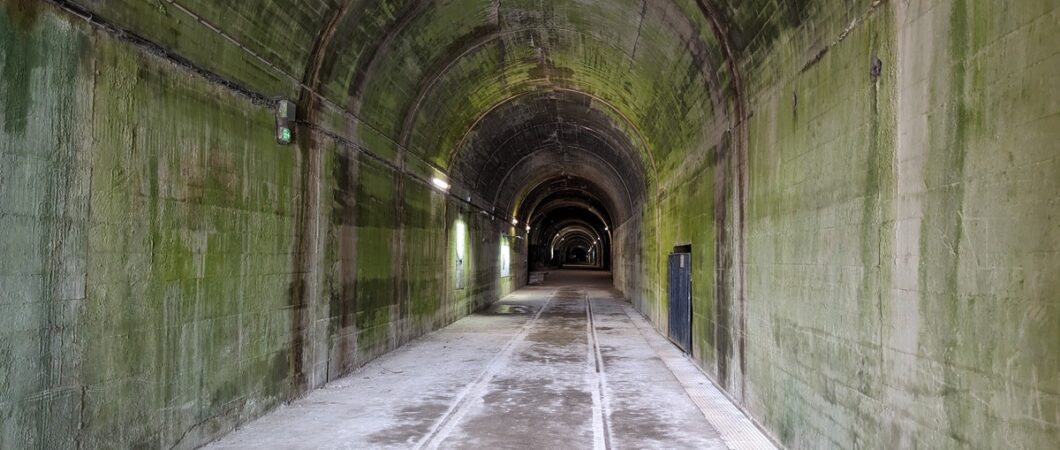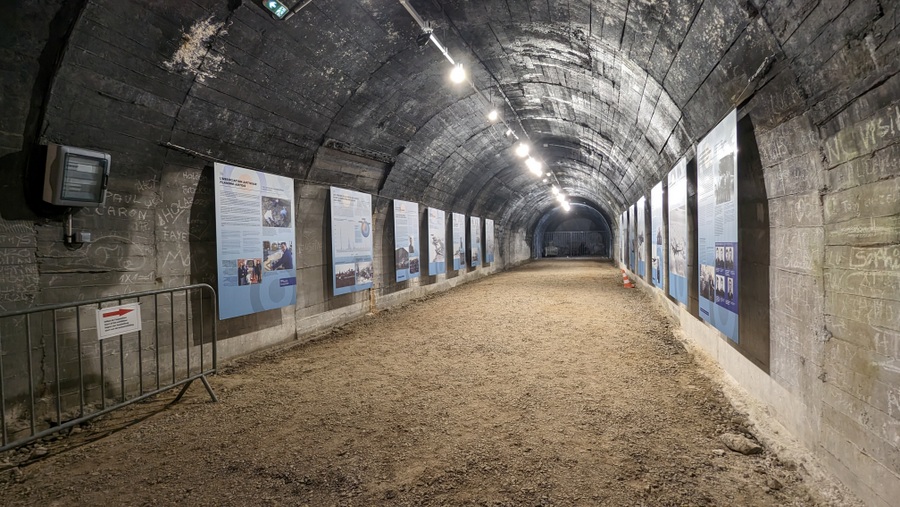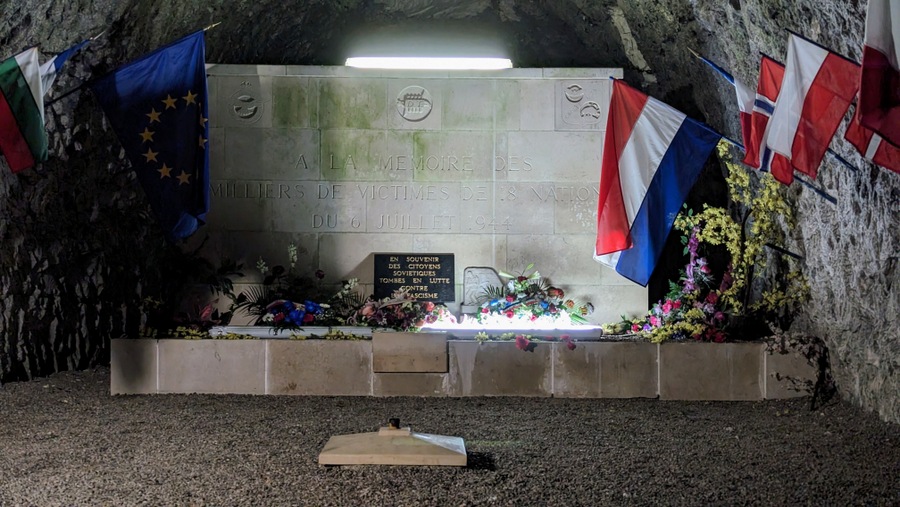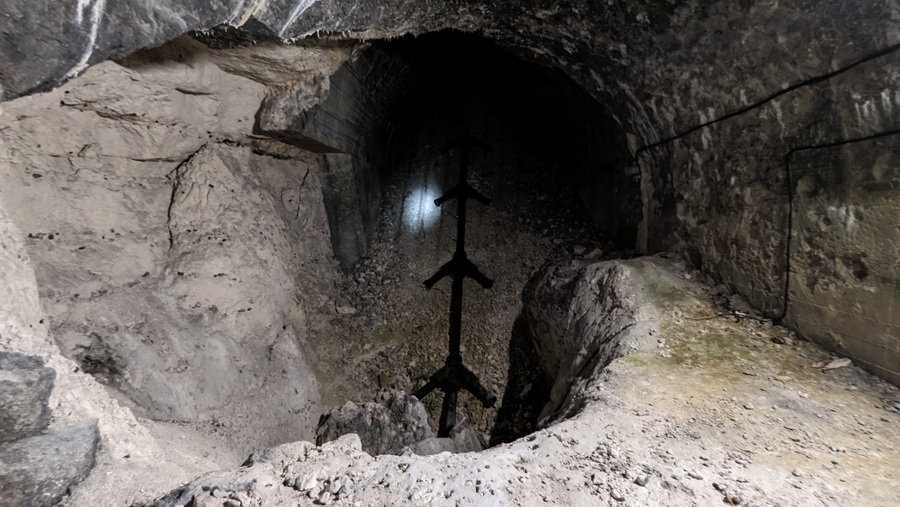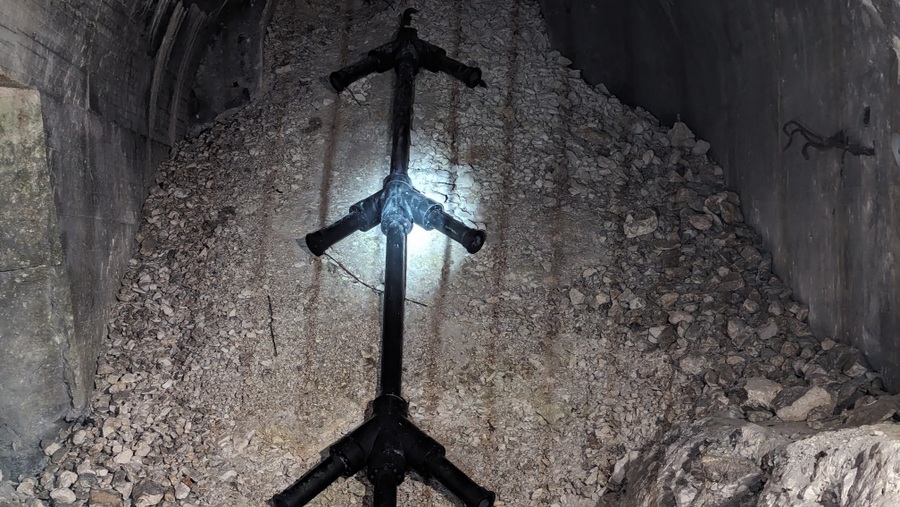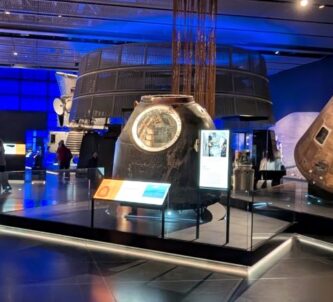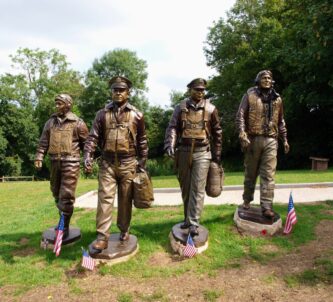The huge World War II underground site in a clay quarry at Mimoyecques was the secret location intended for several batteries of German ultra long range superguns, Hitler’s V3 weapon, aimed at London.
The V-Weapon Programme
The Third Reich’s propaganda ministry first mentioned a sinister programme of Vergeltungs-Waffen (retaliation weapons) in June 1944, as the Allies were coming ashore in Normandy. The first, the V1 flying bombs stated appearing a few days later on 12 June. The V2 rockets began to fall on Paris and London on 8 September.
By this time Propaganda minister Goebbels had made it clear there were more long-range terror weapons to come, although not what form they would take.
The V3 was a high-velocity long-range supergun code-named Hochdruckpumpe (HDP). HDP guns were fixed, high calibre, multi-chamber gun barrels, usually laid up the side of a suitable hill.
The V4, code named Rheinbote was a four-stage solid-fuel rocket, and then the V5 & V6 were not new weapons at all, just upgraded existing guns – the K5 280mm railway gun the Gustav 800mm railway gun – with improved long-range ammunition.
The V3 Hochdruckpumpe
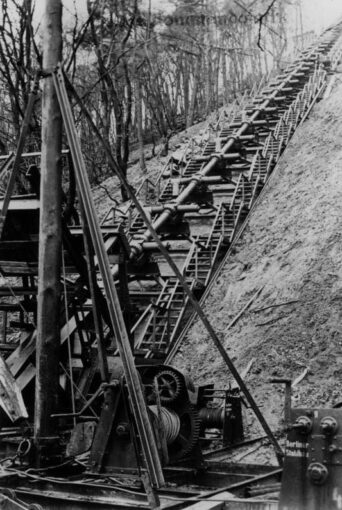
Bild 146-1981-147-30A / CC-BY-SA 3.0)
The idea of a multi-chamber gun with the initial charge at the breech, then multiple booster propellant charges on the side of the barrel, ignited by the flash as the shell passes each, in order to accelerate the shell to its terminal velocity… was first proposed by the French in the mid-19th century. The idea was developed and patented by them at the end of WW1 as a way of hitting back at the German long range railway guns (the ‘Paris Guns’, aka Kaiser Wilhelm Gun or Big Bertha), which had been shelling Paris. The war ended before the French could build one, but 40 years later when the Germans drove into Paris they found the patent!
After some small calibre testing to prove the concept, the armaments company Röchling Eisen-und Stahlwerke GMBH proposed an HDP gun that could fire fin-stabilised shells over a distance of 160 kilometres*, to Armaments Minister Albert Speer, who in turn took the idea to Hitler in early 1943. Naturally Hitler loved the idea of a gun that could reach London, and by the summer of 1943 he had approved the building of two test guns in Germany, but, not wishing to wait for the results, he also ordered a site in France to be prepared.
The Pas-de-Calais V3 site would have to be big. To achieve the required range, shells couldn’t be very heavy. So to have a significant effect, there had to be a lot of them. The original Röchling proposal was for five batteries of 50 barrels, each capable of firing a 140kg shell every 5 minutes, IE. a total of 3,000 shells per hour falling on London!
Later, Mimoyecques, or “Bauwerk 711” (building site 711) as it was codenamed when the Todt organisation’s 5,000 workers started construction in June 1943, would comprise two bunkers, each with only 25 guns, enabling them to still hit London with 600 shells an hour.
The Design and Construction of the V3 site at Mimoyecques
The bunkers were to form a huge, self-contained underground complex with galleries containing powder and ammunition storage, living quarters for the garrison of 1,200 men, power, water and ventilations systems, workshops and general storage. They were supplied through two 600m long railway tunnels, buried 30m underground, with side tunnels running away to the gun shafts.

The 127m long gun shafts – five in each bunker – would each have five gun barrels pointed at London and angled at 50°. They would have had steps dug into them to enable the gun crews to load the side chambers with powder for each firing. The tunnels at the base of the shafts, where the guns would be loaded, were 100m below ground. There were a set of vertical lift shafts to carry ammunition and powder from the 30m service level to the 100m base level. There were also ventilation shafts designed to carry away the fumes when the breeches were opened. At the surface, the gun barrels were protected by a 5m-thick concrete slab, capped with 200mm thick steel plates.
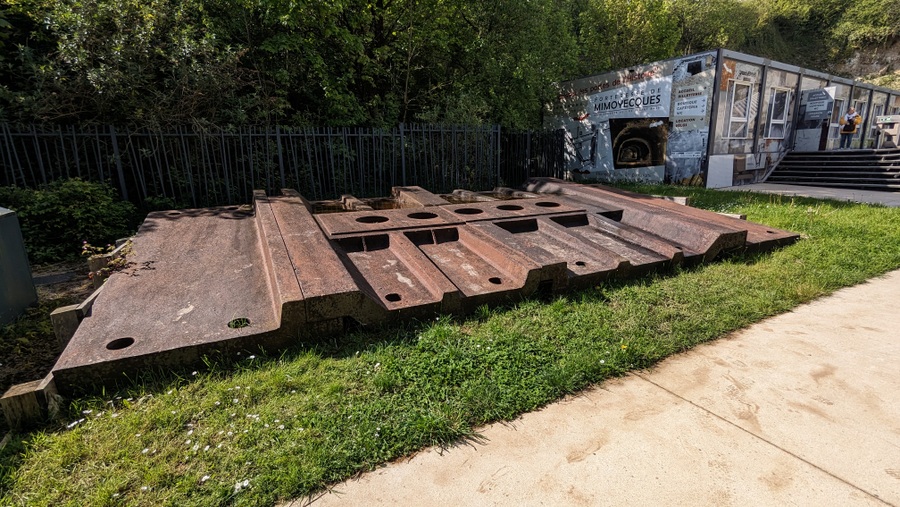
The first Allied bombing attacks (by the US 9th Air Force) were on 5, 8 & 10 Nov 1943. Then a four month respite came, allowing the first concrete slab to be formed and set before the next bombing raids in March 1944. So construction work on the advanced parts of the site was able to continue almost unimpeded.
Unfortunately for the Germans, back in the real world, things were not going so well. Not only was the development of the HDP guns not going smoothly – parts were failing and they were not achieving the velocity or range required – but also, thanks to set backs on the Eastern Front and the relentless Allied bombing of Germany, materials and resources were running low. In March 1944 it was decided to abandon the second bunker entirely and concentrate on just three of the five gun shafts in the first bunker. IE Mimoyecques would be reduced to just 15 guns.
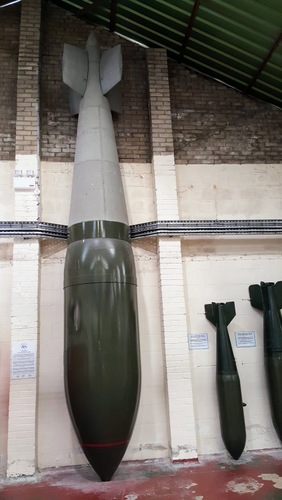
This one at Yorkshire Air Museum
The Germans still hoped to get the base operational. As late as 2 June 1944 a report to Germany said that the first five barrels would be installed by 15 August, the next five by 15 September and the final five by 15 October. But, meanwhile the US Eighth Air Force flew ten bombing raids against Mimoyecques between 19 March and 22 June, when RAF Bomber Command joined in.
The RAF’s 617 Squadron (Dambusters) had Lancaster bombers modified to carry the Barnes Wallis designed 5443 kg (12,000 lb) / 6.4 m (21 ft) Tallboy bomb (not his biggest!). It was designed to travel at supersonic speed and bury itself in the ground before exploding. 617 Sdn had already used it on the V1 & V2 test site at Peenemunde. They dropped them on the battleship Tirpitz, and on the armoured U-boat pens on the French Atlantic coast. In total RAF Lancasters dropped 854 Tallboys during WW2, and on 6 July 1944 they dropped sixteen of them on Mimoyecques, collapsing one of the gun shafts and several galleries.
The heaviest raid in terms of tonnage was the 800 tonnes of bombs delivered by 200+ RAF bombers on 27 August.
As a side note, unbeknown to the Germans, the Allies noticed that after the Tallboy raid, repairs were being made to the damaged railway track and tunnel. So they planned a Project Anvil operation, sending a remote-controlled P-24 Liberator bomber packed with explosives to crash into the railway tunnel entrance. Unfortunately it blew up before leaving England. See The Day a President’s son watched a President’s brother die.
The raid on 27 August was another devastating blow, but THE most devastating blow to the German troops at Mimoyecques had already happened – D-Day. By the time of that last RAF raid, Paris had already been liberated, and the Canadians were quickly working their way up the Channel coast. The 3rd Canadian Division overran Mimoyecques on 5 September 1944. By then the site had already been abandoned.
The Aftermath at Mimoyecques
After its capture, the site was inspected by both the French and the British***. The British team led by Colonel Terence Sanders inspected the remains of the bunker, as far as they could. They certainly attempted to drain water out of the lower levels. It was he and his team who produced the cutaway drawing (above) in his report to the UK government dated 21 February 1945. The conclusion of the report was that Mimoyecques could be repaired and made operational again, and that “the destruction of Mimoyecques should be an absolute priority”.
Churchill agreed and ordered it to be done, however General de Gaulle’s provisional French government were reluctant. Churchill ignored them.
Allies or not, you can understand why. The site had but one function: to bombard London. No matter who controlled it in the short, medium or long term future (and a future conflict with the Russians was already being anticipated) they could only use it for one thing, and no British government could allow that.
In May 1945 a team of Royal Engineers arrived at the site with 36 tonnes of TNT, which they laid out in the 30m tunnels at 38 key structural points and on the surface where the gun shafts emerged in order to blow up the concrete cover. The French were only notified after the explosives were detonated.
Visiting the Forteresse de Mimoyecques
As we now know, Mimoyecques turned out to be a tough nut to crack. Despite all that bombing plus the attention of the Royal Engineers, visitors can still explore quite a large part of the site at the 30m level. Pretty much everything below that is collapsed or flooded.
The entrance looks just as discreet and insignificant as it tried to be in 1944, but behind it is the enormous 650m train tunnel which disappears off into the distance (feature photo). The last 150m and the northern entrance to the rail tunnel are collapsed, as are the adjacent service tunnels at the northern end.
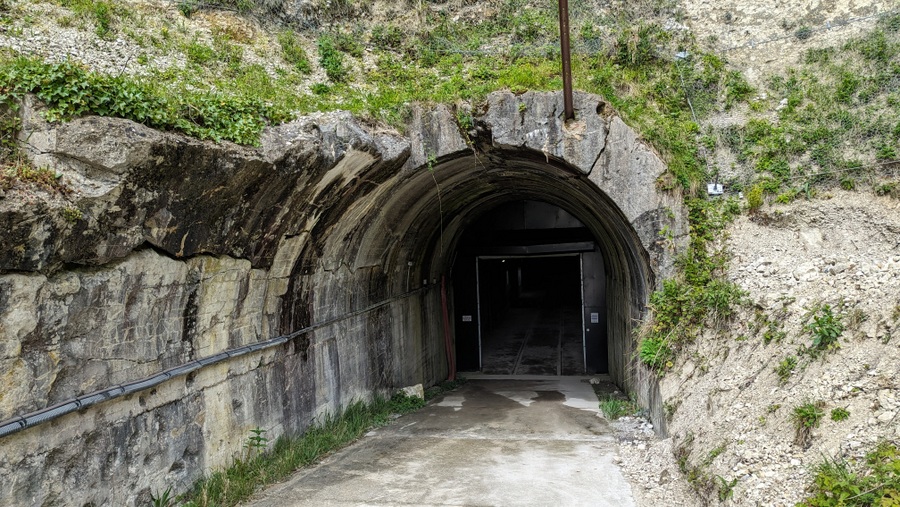
Essentially a guided or self-guided tour will take you along the main rail tunnel, then left down one of the service tunnels leading to the gun shafts, returning to the main tunnel through another service tunnel. Along the way there are plenty of information panels (in multiple languages) and a some memorials, one to the allied airmen who died attacking the site, one to the victims (Todt organisation workers from 18 countries) of the Tallboy raid on 6 July 1944, and a small memorial stone to Joseph Kennedy and his crewmate, Lt. Wilford Willy, who died on the Anvil operation.
At the western end of the service tunnels are what remains of the gun shafts, partially excavated. On one of the slopes, the museum have placed a recreation of a herring-bone HDP gun on the rubble to indicate where the guns were. Of course, if the guns had arrived, the whole shaft would have been concreted in steps with the metal rack supports for the guns, but that was a job the Germans were leaving till the first guns turned up and they would find the exact locations for the support racks before embedding them in the setting concrete.
The popular image of the HDP guns takes the form of a herring-bone, with the side charges angled at 45° but all the operational and experimental guns had right-angle side charges, except one. The US 9th Army found two HDP guns at the German Army’s artillery test range at Hillersleben, just north of Magdeburg. One of them was a herring-bone HDP, thought to be a late refinement. We don’t know for sure what type of HDP gun would have been installed at Mimoyecques – herring-bone or right-angle.
So, was the V3 weapon ever used?
Not at Mimoyecques, no guns were installed or fired, but four shorter barrelled (50m) HDP guns were made operational in November 1944. One pair was installed on a hillside outside at Lampaden in Germany and targeted on Luxembourg fifty kilometres away. The other pair were installed outside Buhl in Alsace targeted at Belfort.
The artillery regiments operating the guns struggled to get the guns installed and armed. By this stage in the war, ammunition supplies were patchy, especially the specialised shells needed for HDP guns. Eventually, between 30 Dec 44 – 22 Feb 45 the Lampaden guns managed to fire 183 shells at Luxembourg. For a ‘super weapon’ the results were pathetic. Four dead, 13 wounded and the only military asset damaged, was a mobile laundry.
The Buhl pair also struggled to get installed. On 1 February, only one gun had been set up, but the military situation was deteriorating so fast the regiment was ordered to dismantle the site and retreat… after first firing a token six shells. By this time the US 10th Armoured Division were only 5 kms away, so it was a bit of a mad scramble.
At the war’s end, all four operational HDP guns were found back in their manufacturer’s yard.
Was that the end of the ‘Supergun’?
Not quite. the supergun concept did not die with the end of the Third Reich.
In the 1960s, a Canadian engineer, Gerald Bull, advanced the concept into the USA/Canada High Altitude Research Project (HARP), which attempted to use supergun technology to fire satellites into space. You can see the remains of the space gun in Barbados.
He was later commissioned by Saddam Hussein to build a supergun for Iraq – the Babylon Gun – and four others. The Babylon Gun was supposedly to put Iraqi satellites into orbit, but the other gun designs could traverse and it was suspected they could be used to fire on Israel****. The Babylon gun never became operational. It was dismantled after the first Gulf war and Bull was mysteriously assassinated in 1990. Several sections of the barrel can be seen in the UK.
Will the supergun idea ever go away? I suspect not. People are even now dreaming up ways of firing projectiles into space… and probably over long-distances on Earth!
* The distance from the French coast to central London is 150km, but the bunkers would have to be set back inland by at least 10 kms to keep them out of range of a Royal Navy bombardment.
** The workers were mostly engineers drafted in from German companies and German miners. In addition there was a slave labour force of Soviet captives.
*** The French team was led by Professors Moreu & Joliot-Curie and produced their report in Jan 1945. The British team was led by Terence Sanders, who before the war had been a University lecturer in engineering, a Member of the Institute of Civil Engineers, a member of the Institute of Mechanical Engineers, and a Territorial Army officer. In 1946 he was appointed Principal Director of Technical Development (Defense) at the Ministry of Supply. In his role as a TA officer he became involved in Operation Crossbow, tracking down V2 rockets.
In the middle of the 2024 Paris Olympics as we are, it would be remiss not to also mention, Sanders was a gold medal winner for Great Britain in the Coxless Four rowing event at the 1924 Olympics, also held in Paris!
**** A test firing in the summer of 1990 achieved a range of 229 kilometres, half the distance to Jerusalem from the borders of Iraq.
Declaration: I was on a press visit to the area. Entry to the museum was complementary.
Factbox
Website: Forteresse de Mimoyecques
Getting there: Forteresse de Mimoyecques
D249, 62250 Landrethun-le-Nord
France.
It’s easy to find. The signage is good. But just so you know, there is no nearby village called ‘Mimoyecques’, only a traditional fortified Norman farm with that name 200m away, and 600m to the east, a hamlet called Moyecques. They are all in the commune of Landrethun-le-Nord, which is also the name of the nearest village. There is parking at the site.
Entry Price (Jul 2024):
| Self guided | Guided | |
| Adult | €7.00 | €9.00 |
| Child (6 to 16) | €5.50 | €7.50 |
| Family (2 adults + up to 5 children) | €16.00 | €22.00 |
The ticket office/reception building also has a cafe and museum shop.

Opening Hours:
Important to know: the remote tunnels and galleries of Mimoyecques are home to around 350 bats of up to 11 different species (Don’t worry if that makes you nervous. You are not likely to encounter any). That’s not many, but it is the most important hibernation site in Northern France. When hibernating, bats live off their reserves and if disturbed, they can die. So, Mimoyecques is closed to visitors from mid-October to mid-April each year. Check on their website for the precise dates.
During the summer, the museum is open daily from 10:00-18:00 seven days a week.

